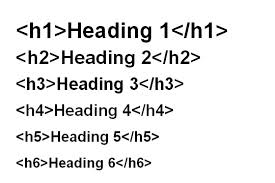Heading tags (H1, H2, H3, H4, H5) are considered one of the most important parts of search engine optimization (SEO). H1 tags should be used on your website pages as the main page headline. These headings should contain targeted keywords and grab the interest of your visitors by describing the page. Not using any heading tags is a common mistake that harms you organic search rankings directly. Also, not optimizing your heading tags by using welcome text as your headings is a waste.
The H1 heading is the most important and the largest of the headings and should always be used first. Other headings such as H2, H3, H4 should follow after the main heading to describe paragraphs and important elements in the content of your pages. Google places more weight on this tag as it’s regarded as the most important part of your page content. Here’s a couple of tips to help you optimize your heading tags for SEO.
Heading tag optimization for SEO
- The main heading of a page should always use the H1 tag. For sub headings, use a H2 and a H3.
- Use primary keywords in the main headings and secondary keywords in the other headings.
- Don’t overuse heading tags on your pages. Use 1 H1 tag, 1 H2, etc. This will guide Google which parts are the most important on your website pages.
- Don’t use sentences in your headings. Keep the heading brief and to the point.
- Never repeat words in your headings as this could be flagged as spam to the search engines. Make it natural.
- Use targeted keywords in the beginning of the headings. Keywords appearing in the front are given more weight by the search engines.
- If you have a large website with products and services, use the product name or service as the H1.
- If you have a blog, the blog post title should have the H1. This is an important part of SEO as blogging can increase your visibility online. Optimize your heading tags for exposure on Google.

